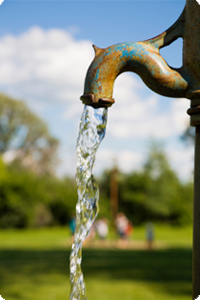A. B. Hoxie, Inc., can help determine the type of well, size of appropriate pump and if needed a water treatment system to address your water well needs.
To determine the type of well to drill, soil depth and water needs are considered.
Types of wells
There are three types of private drinking water wells.
- Dug/Bored wells are holes in the ground dug by shovel or backhoe. They are lined (cased) with stones, brick, tile, or other material to prevent collapse. Dug wells have a large diameter, are shallow (approximately 10 to 30 feet deep) and are not cased continuously.
- Driven or sand point wells are constructed by driving pipe into the ground. Driven wells are cased continuously and shallow (approximately 20 to 50 feet deep). Though driven wells are cased, they can be contaminated easily because they draw water from aquifers near the surface.
- Drilled wells are constructed by percussion or rotary-drilling machines. Drilled wells can be thousands of feet deep and require the installation of casing. Drilled wells have a lower risk of contamination due to their depth and use of continuous casing.
Well components2
Below are descriptions of the basic components found in a private water well.
- Well Casing is the tube-shaped structure placed in the well to maintain the well opening from the target ground water to the surface. Along with grout, the casing keeps dirt and excess water out of the well. This helps prevent contaminants from less desirable groundwater from entering the well and mixing with the drinking water. Some states and local governing agencies have laws that require minimum lengths for casing. The most common materials for well casing are carbon steel, plastic, and stainless steel. Local geology often dictates what type of casing can be used.
- Well Caps are placed on top of the well casing to prevent debris, insects, or small animals from getting into the well. Well caps are usually made of aluminum or plastic. They include a vent to control pressure during well pumping.
- Well Screens are attached to the bottom of the casing to prevent too much sediment from entering the well. The most common well screens are continuous slot, slotted pipe, and perforated pipe.
- Pitless Adapter is a connector that allows the pipe carrying water to the surface to remain below the frost line. It provides ensures that a sanitary and frost-proof seal is maintained.
- Jet Pumps are the most commonly used pumps for shallow wells (depth of 25 feet or less). Jet pumps are mounted above ground and use suction to draw water from the well.
- Submersible Pumps are the most commonly used pumps for deep private wells. The pumping unit is placed inside the well casing and connected to a power source on the surface.
The Water Systems Council had a more detailed well component diagram and other well-owner education materials
Proper well location and construction are key to the safety of your well water. The well should be located so rainwater flows away from it. Rainwater can pick up harmful bacteria and chemicals on the land’s surface. If this water pools near your well, it can seep into it and potentially cause health problems.
Appropriate well construction depends on local geologic and groundwater conditions. Your state water-well contractor licensing agency, your local health department, or a local water system professional can provide information on proper well construction. The National Ground Water Association (NGWA) provides a guide for hiring a water system professional that covers key considerations.
Make sure any water-well drillers and pump-well installers you work with are licensed and insured. Rhode Island requires ground water contractor is licensed and certified. Go to Rhode Island Contractors Registration Board website https://crb.ri.gov/search/contractor-search where it says Company Name type in hoxie then Submit Query Visit the National Ground Water Association to find certified water well contractors near you. The NGWA operates its own voluntary certification program for contractors . This allows drillers, and well pump installers can receive national training certification on top of state requirements. Some states actually use the Association’s exams as their test for licensing.
Last updated on December 3, 2024



